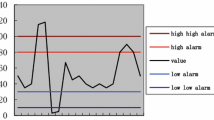Abstract
The state grid information system is complex, the operation and maintenance information are diverse, involving a wide range of aspects. It becomes a key problem that how to use the alarm log of the operation and maintenance system to analyze the root cause of the fault. At present, there is a lack of alarm correlation technology for operation and maintenance system, and the traditional method lacks mature application systems for new scenarios. The reliability and efficiency of operation and maintenance system not only depends on the accurate collection of equipment fault information, but also depends on how to analyze massive fault information effectively and quickly, so as to grasp the key, handle the key, solve the key, three “keys”. In this context, a Bi-Apriori algorithm is proposed, to solve the problem of frequently scanning the dataset and generating a large number of candidate set. It adopts the vertical data structure to mine frequent items and then as for alarm logs the proposed Bi-Apriori can be used to mining frequent items from alarm logs. Experimental results show that the proposed Bi-Apriori algorithm is superior to the existing association rule discovery algorithms on several datasets in real applications, especially for the dataset of alarm logs.
Access this chapter
Tax calculation will be finalised at checkout
Purchases are for personal use only
Similar content being viewed by others
References
Borgelt, C., Kruse, R.: Induction of Association Rules, Apriori Implementation. In: Compstat, pp. 395–400. Physica-Verlag HD (2002)
Cheng, M., Zhou, X.: Optimization of apriori algorithm based on matrix. Comput. Modernization 12, 5–7 (2008)
Miao, M., Wang, Y.: Research on improvement of apriori algorithm based on matrix compression. Comput. Eng. Appl. 49(1), 159–162 (2013)
Zhao, X., Sun, Z., Yuan, Y., Chen, Y.: An improved apriori algorithm for orthogonal linked table storage. J. Chin. Comput. Syst. 37(10), 2291–2295 (2016)
Yanyan, Yu., Li, S.: Improved aprioritid algorithm for correlation rules based on hash. Comput. Eng. 34(5), 60–62 (2008)
Ji, H.: Apriori, improved algorithm based on frequent 2 item set support matrix. Comput. Eng. 11, 183–186 (2013)
Lin, Z.: A divide-and-conquer apriori algorithm for generating frequent itemsets directly. J. Comput. Appl. Softw. 4, 297–301 (2014)
Zhang, Y., Xiong, Z., Geng, X., Chen, J.: Analysis and improvement of eclat algorithm. Comput. Eng. 36(23), 28–30 (2010)
Huseyinov, I., Aytac, U.C.: Identification of association rules in buying patterns of customers based on modified apriori and eclat algorithms by using R programming language. In: 2017 International Conference on Computer Science and Engineering (UBMK), Antalya, pp. 516–521 (2017)
Du, J., Zhang, X., Zhang, H., Chen, L.: Research and improvement of apriori algorithm. In: 2016 Sixth International Conference on Information Science and Technology (ICIST), Dalian, pp. 117–121 (2016)
Acknowledgements
This research was financially supported by the Science and Technology projects of State Grid Corporation of China (No. 500623723).
Author information
Authors and Affiliations
Corresponding author
Editor information
Editors and Affiliations
Rights and permissions
Copyright information
© 2021 The Editor(s) (if applicable) and The Author(s), under exclusive license to Springer Nature Switzerland AG
About this paper
Cite this paper
Yao, F., Li, A., Wang, Q. (2021). Bi-Apriori-Based Association Discovery via Alarm Logs. In: MacIntyre, J., Zhao, J., Ma, X. (eds) The 2020 International Conference on Machine Learning and Big Data Analytics for IoT Security and Privacy. SPIOT 2020. Advances in Intelligent Systems and Computing, vol 1283. Springer, Cham. https://doi.org/10.1007/978-3-030-62746-1_91
Download citation
DOI: https://doi.org/10.1007/978-3-030-62746-1_91
Published:
Publisher Name: Springer, Cham
Print ISBN: 978-3-030-62745-4
Online ISBN: 978-3-030-62746-1
eBook Packages: Intelligent Technologies and RoboticsIntelligent Technologies and Robotics (R0)




